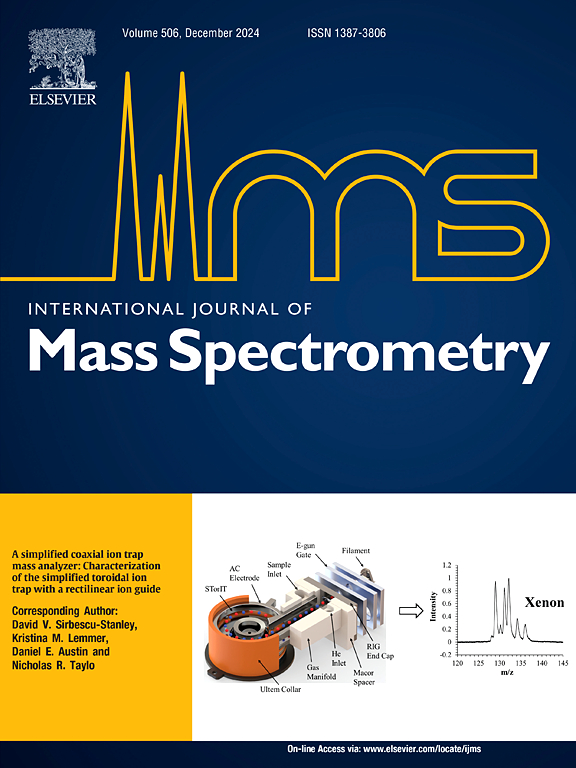Ion mobility-assisted free radical-initiated peptide sequencing
IF 1.7
3区 化学
Q3 PHYSICS, ATOMIC, MOLECULAR & CHEMICAL
引用次数: 0
Abstract
Free radical-initiated peptide sequencing (FRIPS) is a tandem mass spectrometry technique (MS/MS) that enables radical-based dissociation on instruments only capable of collisional activation. In FRIPS, peptides are chemically-derivatized with a compound that undergoes homolytic cleavage and generates radicals upon collisional activation. These radicals then propagate through the peptide backbone enabling the sequencing of peptide ions. This MS/MS technique has shown promise in sequencing post-translationally modified peptides, but it is typically performed in an MS3 workflow and single-step MS/MS approaches result in the generation of both collisional- and radical-driven dissociation products and highly complex spectra. Recently, our group developed a method to dissociate peptide ions prior to ion mobility analysis within a trapped-ion mobility spectrometry (TIMS) device. In this work, we examine if this “CIDtims” technique can initiate the homolytic cleavage of the FRIPS precursor. We then examine if the resultant ion mobility separation results in additional assignments of product ions and improved sequence coverage. We demonstrate that activation within the TIMS device does indeed promote robust radical initiation and fragmentation of peptide cations and that the generated product ions are mobility separated enabling facile assignment and increased sequence coverage.

离子迁移辅助自由基启动肽测序。
自由基启动肽测序(FRIPS)是一种串联质谱技术(MS/MS),能够在仅能够碰撞激活的仪器上进行基于自由基的解离。在FRIPS中,肽是由一种化合物化学衍生的,该化合物经过均裂裂解并在碰撞激活时产生自由基。然后,这些自由基通过肽主链传播,从而实现肽离子的排序。这种MS/MS技术在测序翻译后修饰肽方面显示出前景,但它通常在MS3工作流程中进行,单步MS/MS方法导致产生碰撞和自由基驱动的解离产物和高度复杂的光谱。最近,我们的团队开发了一种方法,在离子迁移率分析之前,在捕获离子迁移率光谱(TIMS)设备中解离肽离子。在这项工作中,我们研究了这种“CIDtims”技术是否可以启动FRIPS前体的均溶裂解。然后,我们检查所产生的离子迁移分离是否会导致产品离子的额外分配和改进的序列覆盖。我们证明了TIMS装置内的激活确实促进了自由基的激活和肽阳离子的断裂,并且生成的产物离子是可迁移的,可以方便地分配和增加序列覆盖。
本文章由计算机程序翻译,如有差异,请以英文原文为准。
求助全文
约1分钟内获得全文
求助全文
来源期刊
CiteScore
3.60
自引率
5.60%
发文量
145
审稿时长
71 days
期刊介绍:
The journal invites papers that advance the field of mass spectrometry by exploring fundamental aspects of ion processes using both the experimental and theoretical approaches, developing new instrumentation and experimental strategies for chemical analysis using mass spectrometry, developing new computational strategies for data interpretation and integration, reporting new applications of mass spectrometry and hyphenated techniques in biology, chemistry, geology, and physics.
Papers, in which standard mass spectrometry techniques are used for analysis will not be considered.
IJMS publishes full-length articles, short communications, reviews, and feature articles including young scientist features.

 求助内容:
求助内容: 应助结果提醒方式:
应助结果提醒方式:


